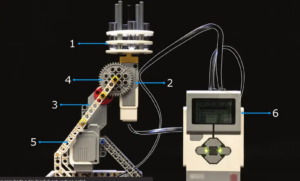A robot made by schoolchildren from lego blocks could speed up and simplify the construction of tiny structures from DNA that could be used as biological machines.
“It started as a thesis for an undergraduate lab course,” said Rizal Hariadi of Arizona State University, who assigned his class to build tools using “frugal science.”
A robot built by one group of students has proven particularly useful and resembles a single arm with a cylindrical tube holder on top. It performs the procedure of mixing the liquid contents of the tubes by first tilting the tubes from vertical to horizontal, then rapidly rotating them. This creates a single fluid whose density decreases uniformly from bottom to top.
The parts of the robot, including gears, connecting blocks and two motors, are all from Lego sets. The only exception is the pipe holder, which the researchers had to 3D print. The robot design is a smaller and faster version of more traditional “gradient mixers”.
After mixing with a Lego robot, the liquid can be used to clean tiny structures made of DNA molecules that scientists like Hariadi want to use as tiny machines. These machines can both perform tasks inside cells and shed new light on the functioning of naturally occurring molecular machines such as proteins.
Many conventional methods of creating density gradients require cumbersome and expensive machinery. The Lego robot created the necessary density gradient in just 1 minute.
Source: New Scientist

